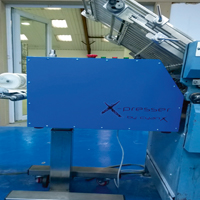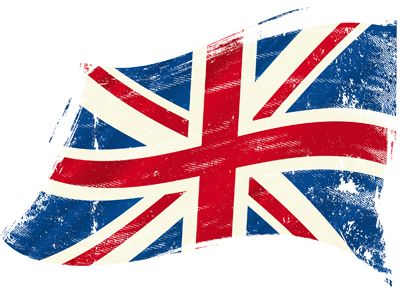These may not be considered halcyon days for British manufacturing or ingenuity, but in the printing industry there remain a number of world class companies supplying the world from these shores. Here are a few of them.
CyanX
Industry perspective:
CyanX Ltd near Leeds is having great success with the now award-winning eco-seal aqueous coating. ‘We have plans to launch this product in mainland Europe and the USA before drupa, so we are certainly looking at a busy new year,’ said managing director Richard Mawson.
‘We have eco-seal running on many litho presses now with great success, but have found some companies could not get the required pressure to activate the adhesive bond. We now have X-presser: our very own finishing solution for the unique eco-seal application.’
Star product: The X-presser is designed to work along-side existing finishing equipment at smaller print companies. CyanX sees it as a great opportunity to break in to the popular direct mail market and make use of its eco-seal aqueous coating to create one piece mailers.
The machine has a solid steel frame side construction and hardened steel pressing rollers. It has variable speed control up to 8000 sheets per hour, and comes with a height-adjustable stand to work with most folding equipment. CyanX has included a full Vernier adjustment system to suit all paper stocks. The machine is designed and manufactured by CyanX in the UK.
‘With more digital print companies showing an interest in this product, we are now working and testing with an offline coater manufacturer to provide a solution for them,’ said Mr Mawson. ‘Tests will be taking place in December on both the coating quality and compatibility of various digital print processes. Digital Printer magazine will no doubt keep you up to date as we progress.’

Cyanx manufactures the x-presser in the UK
LumeJet
Industry perspective:
LumeJet’s Paul Anson: ‘One only has to look at entries in any print awards ceremony to see extraordinary creativity in design and finishing. It’s truly impressive and keeps print exciting and fresh. But there is a problem: it’s called Retina Display, 4K television or any label meaning ‘stunningly impressive, high-resolution’ as seen now on most devices costing £100-plus. It’s only going to get better and cheaper.
‘This isn’t the death of print, but we cannot look at digital just as a method of doing what we used to do but in smaller, economic runs. “We’re as good as offset” isn’t going to cut it in 2020 when the display on your fridge looks better. Whatever digital technology we are talking about, driving print quality to match analogue approaches will be insufficient to protect our industry in the age of the “Internet of Things”.’
Star product:
The new LumeJet trade print service: ‘LumeJet S200 photonic print has been called “sublime”, “effectively beautiful” and “best print and photo quality ever seen”, by respected professionals. LumeJet print is now available both from our London users and direct via our new Coventry trade print service. Applications are premium photoproducts and documents such as look books, coffee table books, premium enlargements and iPhone panoramas. The service is available to trade without capital investment or leases – forever. Sustainable, mutual profitability is our goal, through service provision and machine outplacement. Our plan is that the best print in the world, combined with a revolutionary commercial approach, will raise the bar and create accessibility and differentiation.’
Morgana Systems
Industry Perspective:
Creasing versus Scoring: The blade and matrix creasing mechanism used on Morgana products is a patented solution introduced in 2000, and is still a worldwide best-selling product for this task.
The first product to incorporate this technology, the Morgana AutoCreaser, was a breakthrough machine because it was the first fast, affordable and easy-to-operate way of applying a quality blade and matrix crease to digital output. Prior to this, the creasing task had to be done by hand, or by employing a cylinder or platen press.
Morgana believes that truecreasing, as provided by several Morgana products including the DigiFold, is significantly more effective thanscoringwhen working with digitally printed, heavy weight or cross grained stock.
Star Product:
DigiFold Pro: The Digifold Pro is Morgana’s easy to use, stand-alone folding and creasing machine, first introduced in 2001. It employs a unique creasing rule and matrix, the DynaCrease, which creases without stopping the sheet, giving the highest possible production speeds.
Morgana said: ‘The patented creasing technology sets this machine apart from the rest, still giving it an edge in the world of finishing for digital print.’
The 6000 A4 sheets per hour product can be used as an integrated creaser/folder, performing both functions in one pass; as a stand-alone creaser when folding is not required; or as a perforator when this finish is required. A maximum sheet size of 700 mm x 385 mm (900 mm x 385 mm with optional extension table) allows for a wide range of jobs to be produced.
More than 20,000 Morgana devices have been shipped incorporating this blade and matrix technology – a true Best of British success story!
Tharstern
Industry perspective:
Tharstern says: ‘The trend towards integrated ‘best of breed’ workflows continues with companies now moving towards solutions that have open APIs. They want to be able to select the best providers for each area of their business, including cloud-based solutions, and integrate them together. Going down this path also helps them to future-proof their investment. The US market has been particularly welcoming, despite the fact that we’re a British company, for this very reason. They want to work with independent suppliers that make it easy for them to cherry pick the best solutions for each part of the business.’
Star product:
‘Our core MIS has always been our best seller and it continues to attract new customers to our platform month on month. The fact that it supports all print disciplines including roll labels and packaging is not only great news for label and packaging companies but it is also great news for printing companies who may decide, in the future, to expand into other markets.
Following our recent rebrand exercise, our MIS is now simply called ‘Tharstern’, and we’ve been working on new features for the next version release in early 2016. We’re also working on some great new integrations with partners, including those with open APIs and cloud-based solutions. We’re particularly excited about marketing software that generates printed communications as part of an automated marketing workflow – we see future as the printed and digital worlds working together.’
Vpress
Industry perspective:
Tim Cox: ‘Many times the due diligence you put in place when buying new or replacement technology covers what you need now and tends to leave the technology company pitching for your work to conduct a generic approach to your business requirements. There are many areas that can in time snag a number of your expectations.
Things to check include:
Does the technology have robust, open APIs (Application Programming Interface) or Web Services that mean you can also oversee development independent of the manufacturer etc.? Is the technology open to integration and not subject to any proprietary relationships that may restrict it from being integrated into ANY other third party technology (MIS, production workflow and beyond)? Is the administration of the system easily manipulated without the use of programming skills to cope with changes and configurations in user privileges, department/cost codes, pricing, taxation, authorisation etc.?’
Star product:
Coreprint: The Coreprint ‘cloud’ based platform is fully internationalised, is not dependent upon proprietary software and has fully open, robust Web Services APIs that allow integration with any system i.e. MIS, accounts, production workflow and beyond. Its UK-based development, hosting and Vpress’ unique approach to support is unrivalled in this sector. Affordable scalability allows expansion and diversity of the platform at your pace into image and data management using its DAM (Digital Asset Management), mass personalisation (VDP). It provides modules and links into vouchering, incentive & reward, stock management, RFQ (Request for Quotation) and open campaign tools.
Watkiss Automation
Industry perspective:
British innovation is alive and well, says Watkiss. Great Britain has long been a hot bed of innovation – from steam engines to the World Wide Web and from lawn mowers to chocolate bars – and the potential of innovation to transform our lives is as great as it has ever been. There are countless examples in the printing industry too.
Watkiss is one of the British manufacturers flying the flag at drupa. Paul Attew, sales director at Watkiss explains: ‘We are well known as a leading innovator in print finishing. Our SquareBack book technology is a patented innovation that has changed how stitched booklets are produced worldwide. Drupa is our opportunity to show that British innovation is alive and well.’
Star Product: Watkiss’ PowerSquare 224 booklet maker: The Watkiss PowerSquare 224 is a streamlined booklet making solution for digital printers, producing stitched, SquareBack books up to 224 pages thick. It is available in three configurations: online, offline and nearline; and connects to a growing range of digital printers.
Key to the quality and performance of the PowerSquare is its dynamic adjustment system that optimises stitching, folding and forming according to the page count – so you get perfect stitch and book quality, regardless of whether the book has two pages or 224 pages, without operator intervention.
In the last few months, Watkiss has announced new connectivity to Xerox Versant 2100 and iGen5 printers, Konica Minolta bizhub Press 2500P, 1250P and 1052; and to Ricoh’s new C7100, C9100 and 8100 series printers.





